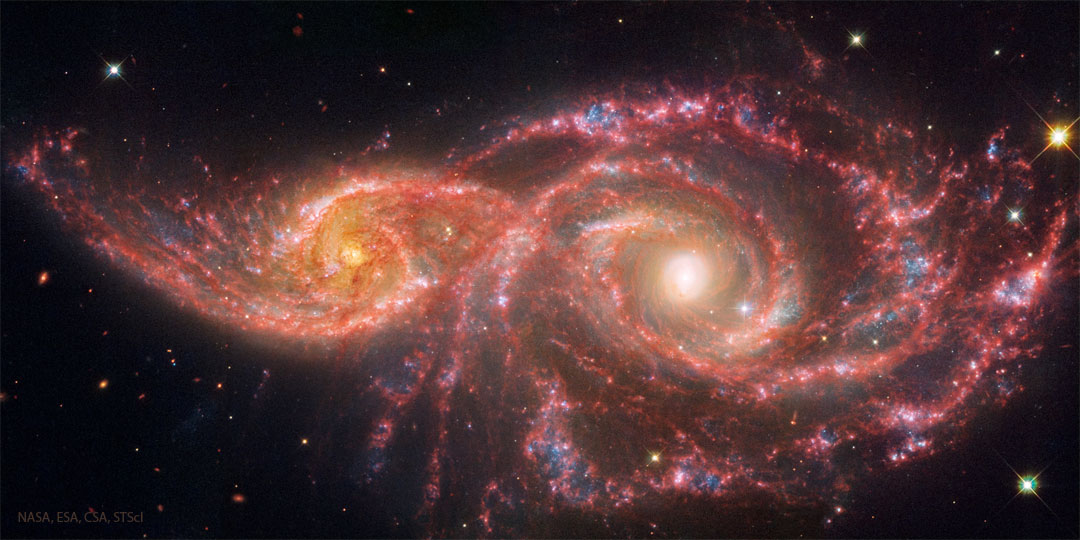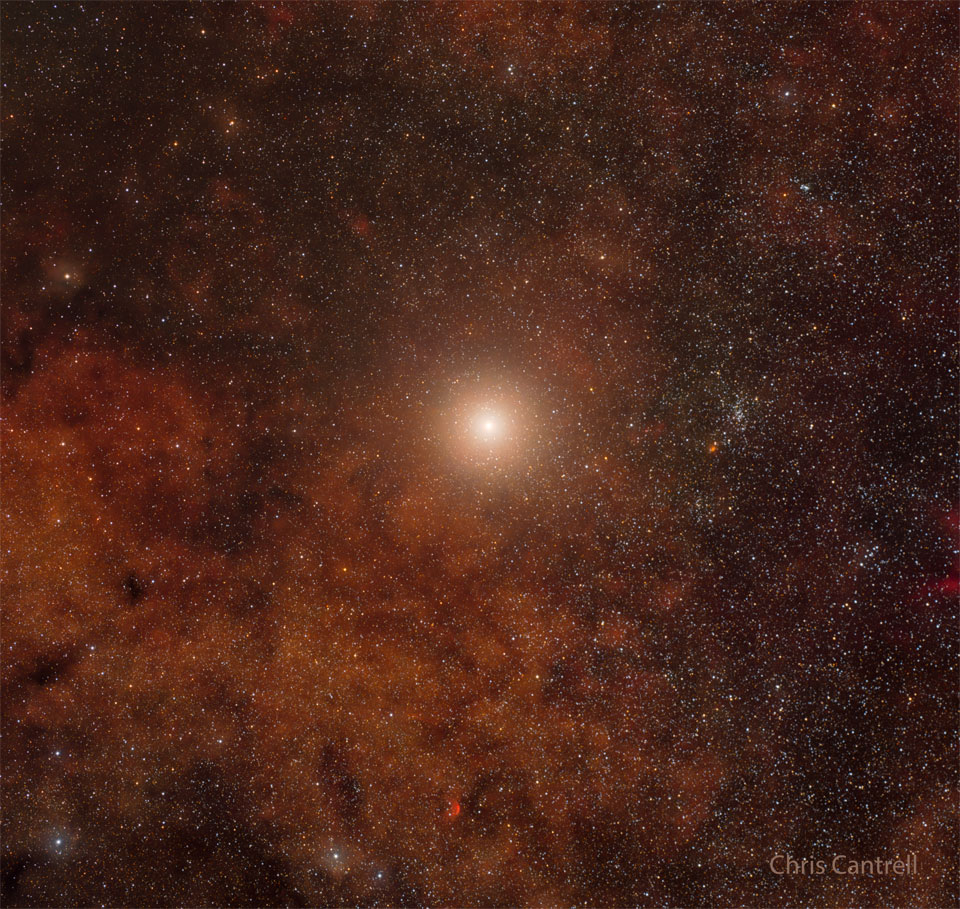Nombre total de pages vues
06/01/2025
ASTRONOMIE - Les plus beaux astres de la Voie Lactée - Saturne et ses anneaux
SANTé/MEDECINE - LES INGREDIENTS A BANNIR AU SUPERMARCHé - Le glutamate monosodique
ASTRONOMY - Colliding Spiral Galaxies from Webb and Hubble
2025 January 6
Image Credit: NASA, ESA, CSA, STScI
Explanation: Billions of years from now, only one of these two galaxies will remain. Until then, spiral galaxies NGC 2207 and IC 2163 will slowly pull each other apart, creating tides of matter, sheets of shocked gas, lanes of dark dust, bursts of star formation, and streams of cast-away stars. The featured image in scientifically assigned colors is a composite of Hubble exposures in visible light and Webb exposures in infrared light. Astronomers predict that NGC 2207, the larger galaxy on the right, will eventually incorporate IC 2163, the smaller galaxy on the left. In the most recent encounter that about peaked 40 million years ago, the smaller galaxy is swinging around counter-clockwise and is now slightly behind the larger galaxy. The space between stars is so vast that when galaxies collide, the stars in them usually do not collide.
05/01/2025
ASTRONOMY - Rocket Launch as Seen from the International Space Station
2025 January 5
Video Credit: ISAA, NASA, Expedition 57 Crew (ISS);
Processing: Riccardo Rossi (ISAA, AstronautiCAST); Music: Inspiring Adventure Cinematic Background by Maryna
Explanation: Have you ever seen a rocket launch -- from space? A close inspection of the featured time-lapse video will reveal a rocket rising to Earth orbit as seen from the International Space Station (ISS). The Russian Soyuz-FG rocket was launched in November 2018 from the Baikonur Cosmodrome in Kazakhstan, carrying a Progress MS-10 (also 71P) module to bring needed supplies to the ISS. Highlights in the 90-second video (condensing about 15-minutes) include city lights and clouds visible on the Earth on the lower left, blue and gold bands of atmospheric airglow running diagonally across the center, and distant stars on the upper right that set behind the Earth. A lower stage can be seen falling back to Earth as the robotic supply ship fires its thrusters and begins to close on the ISS, a space laboratory that celebrated its 25th anniversary in 2023. Astronauts who live aboard the Earth-orbiting ISS conduct, among more practical duties, numerous science experiments that expand human knowledge and enable future commercial industry in low Earth orbit.
04/01/2025
ASTRONOMY - Welcome to Perihelion
2025 January 4
Image Credit & Copyright: Peter Ward (Barden Ridge Observatory)
Explanation: Earth's orbit around the Sun is not a circle, it's an ellipse. The point along its elliptical orbit where our fair planet is closest to the Sun is called perihelion. This year perihelion is today, January 4, at 13:28 UTC, with the Earth about 147 million kilometers from the Sun. For comparison, at aphelion on last July 3 Earth was at its farthest distance from the Sun, some 152 million kilometers away. But distance from the Sun doesn't determine Earth's seasons. It's only by coincidence that the beginning of southern summer (northern winter) on the December solstice - when this H-alpha picture of the active Sun was taken - is within 14 days of Earth's perihelion date. And it's only by coincidence that Earth's perihelion date is within 11 days of the historic perihelion of NASA's Parker Solar Probe. Launched in 2018, the Parker Solar Probe flew within 6.2 million kilometers of the Sun's surface on 2024 December 24, breaking its own record for closest perihelion for a spacecraft from planet Earth.
03/01/2025
ASTRONOMIE - Les plus beaux astres de la Voie Lactée - La lune
ASTRONOMY - Eclipse pair
2025 January 3
Image Credit & Copyright: Josh Dury
Explanation: Eclipses tend to come in pairs. Twice a year, during an eclipse season that lasts about 34 days, Sun, Moon, and Earth can nearly align. Then the full and new phases of the Moon, separated by just over 14 days, create a lunar and a solar eclipse. But only rarely is the alignment at both new moon and full moon phases during a single eclipse season close enough to produce a pair with both total (or a total and an annular) lunar and solar eclipses. More often, partial eclipses are part of any eclipse season. In fact, the last eclipse season of 2024 produced this fortnight-separated eclipse pair: a partial lunar eclipse on 18 September and an annular solar eclipse on 2 October. The time-lapse composite images were captured from Somerset, UK (left) and Rapa Nui planet Earth. The 2025 eclipse seasons will see a total lunar eclipse on 14 March paired with a partial solar eclipse on 29 March, and a total lunar eclipse on 8 September followed by a partial solar eclipse on 21 September.
01/01/2025
ASTRONOMY - Alpha Centauri: The Closest Star System
2025 January 1
Image Credit & Copyright: Telescope Live, Heaven's Mirror Observatory; Processing: Chris Cantrell
Explanation: The closest star system to the Sun is the Alpha Centauri system. Of the three stars in the system, the dimmest -- called Proxima Centauri -- is actually the nearest star. The bright stars Alpha Centauri A and B form a close binary as they are separated by only 23 times the Earth- Sun distance - slightly greater than the distance between Uranus and the Sun. The Alphasystem is not visible in much of the northern hemisphere. Alpha Centauri A, also known as Rigil Kentaurus, is the brightest star in the constellation of Centaurus and is the fourth brightest star in the night sky. Sirius is the brightest even though it is more than twice as far away. By an exciting coincidence, Alpha Centauri A is the same type of star as our Sun, and Proxima Centauri is now known to have a potentially habitable exoplanet.
ASTRONOMY - Orion and the Ocean of Storms
2025 December 13 Orion and the Ocean of Storms Image Credit: NASA , Artemis 1 Explanation: On December 5, 2022, a camera on board the u...

-
2022 September 26 All the Water on Planet Earth Illustration Credit: Jack Cook, Adam Nieman, Woods Hole Oceanographic Institution ; Data ...
-
2025 May 11 The Surface of Venus from Venera 14 Image Credit: Soviet Planetary Exploration Program , Venera 14 ; Processing & Copyri...







